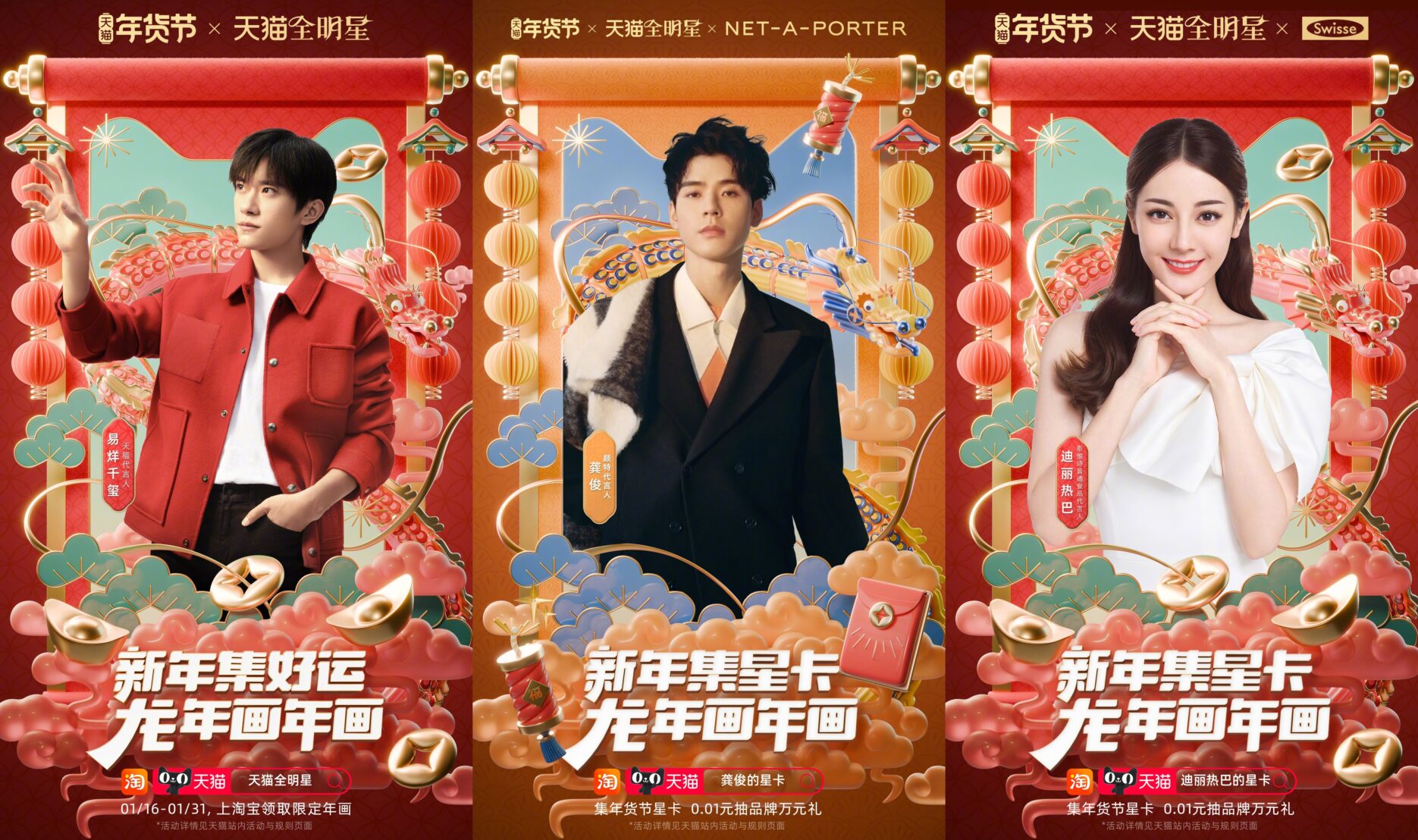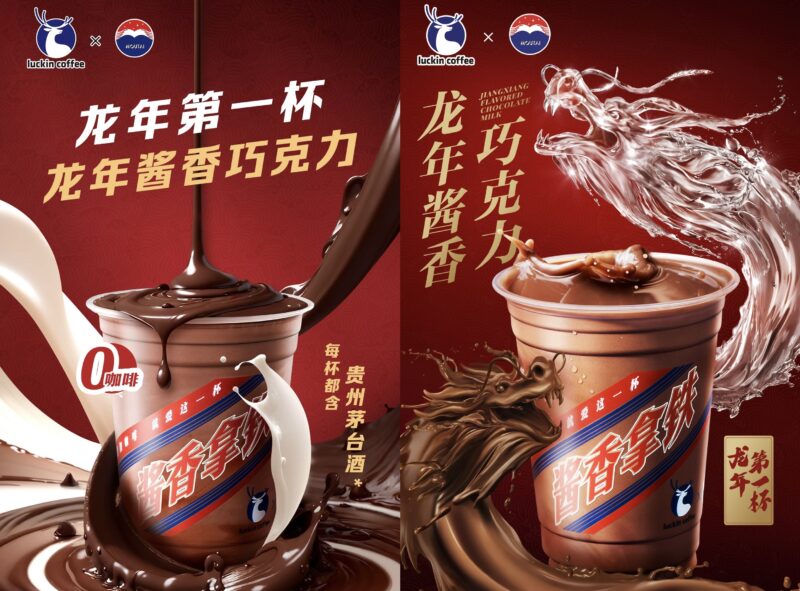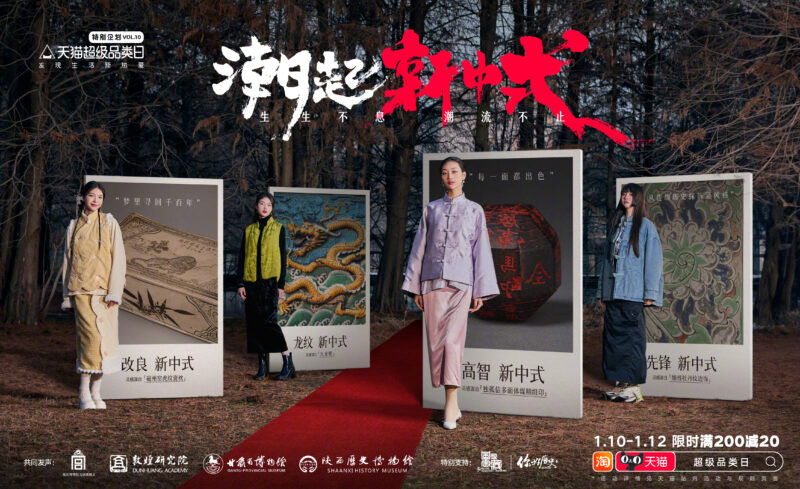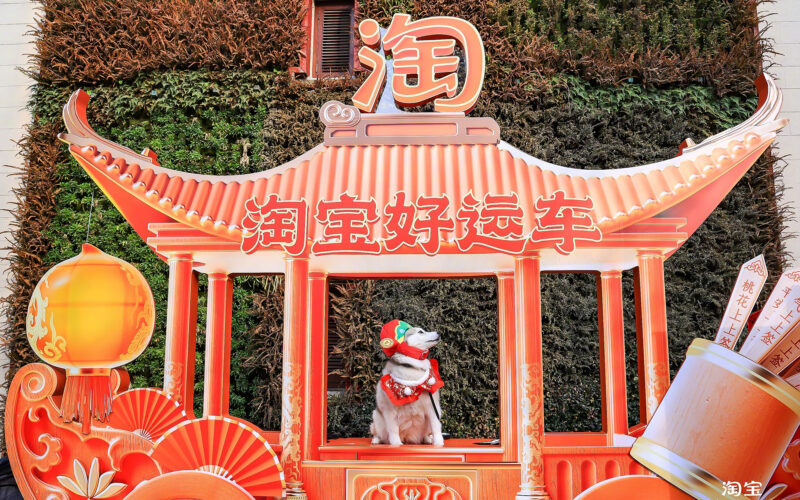Key takeaways:
- Tmall has launched a multiphase, multipronged campaign featuring a celebrity photo card collection and AI-co-created New Year pictures.
- It also links to other platforms such as Xianyu and Weibo, allowing further traffic to be drawn to Tmall.
- Alipay released an early version of the event last year and this year the payment platform has launched 4 different AI-driven interactive touchpoints.
As the Year of the Dragon approaches, Alibaba has launched its CNY campaigns with Tmall and other platforms. Focusing on interactivity and digital collectibles, e-commerce platform Tmall’s new campaign is a multiphase and multipronged effort for the platform to be interactive.
Dot the (dragon) eyes and cross the Tmall
The main attraction of the campaign, is, of course, the celebrity card collectibles. Cards feature top stars like Tmall ambassador Jackson Yee, actress Yang Mi and actor Wang Yibo.



For the first phase, users log into the card draw pages on Tmall, most of which are from branded merchants, and draw the cards of celebrities or IPs they want. Each card contains wishes for the Chinese New Year. When a user completes a set of 7 cards of a certain celebrity, they can advance to the next step – a New Year co-created picture with their favourite star.
The New Year picture, or Nian Hua (年画), is a type of traditional decorative picture for the Chinese New Year holiday period
The New Year picture, or Nian Hua (年画), is a type of traditional decorative picture for the Chinese New Year holiday period. Traditionally in woodblock painting form, the new norm is digitally printed New Year pictures.



The celebrity-fan-AI co-creation of New Year pictures starts from doodles of dragons or the Chinese character of “dragon” (both simplified “龙” or traditional “龍”) drawn by celebrities (sometimes with the help of others or AI already). The users then dot the eyes of the dragons (as in the proverb “画龙点睛” or “dot the eyes of the dragon”, meaning the finishing touch). The AI algorithm will then determine which type of eye the user-drawn one is before the completed doodle is transformed by AI into a full-fledged New Year picture.
Getting physical
For those who are not into celebrities, cards featuring popular IPs such as LEGO, Sanrio Characters, Maltese/Line Puppy and Loopy are also available for collection. These cards often contain “mood” or “literally me” style meme texts that young netizens can relate to, since many of these IPs are used as stickers or memes already.
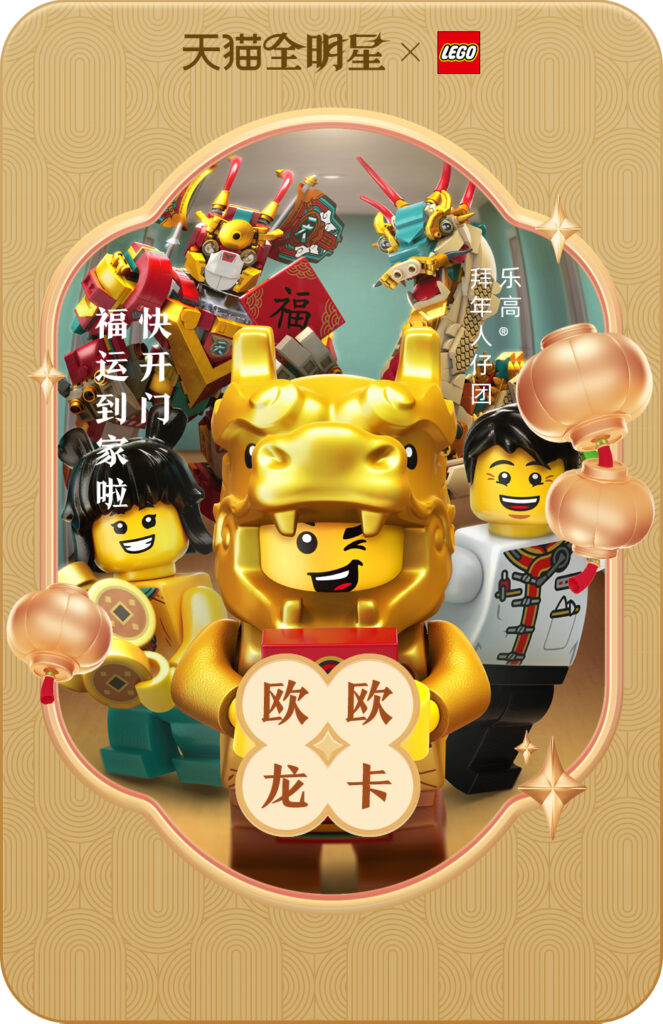
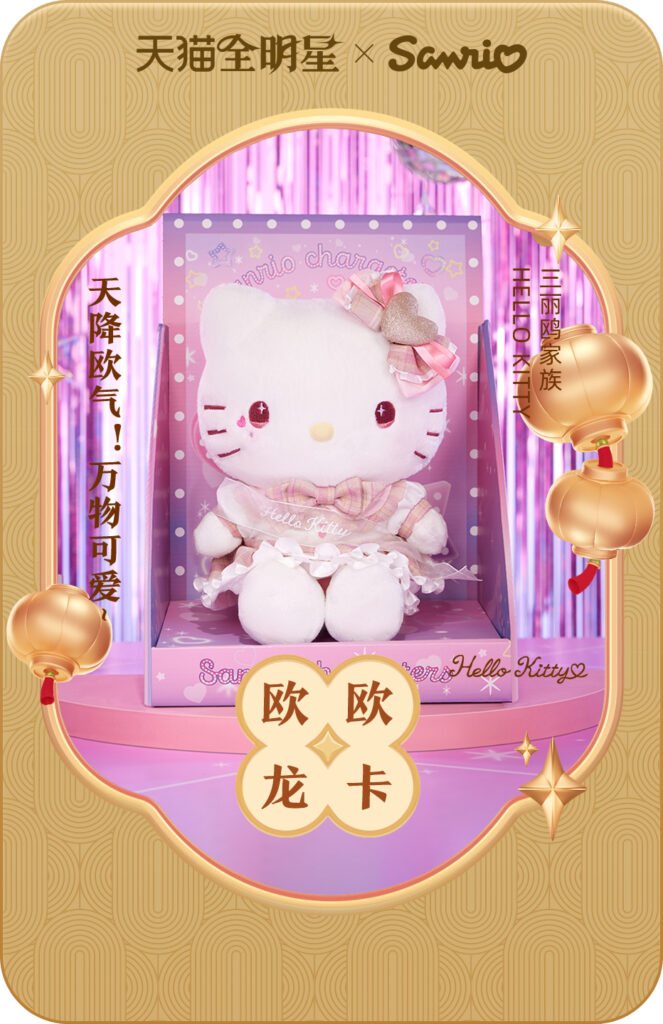
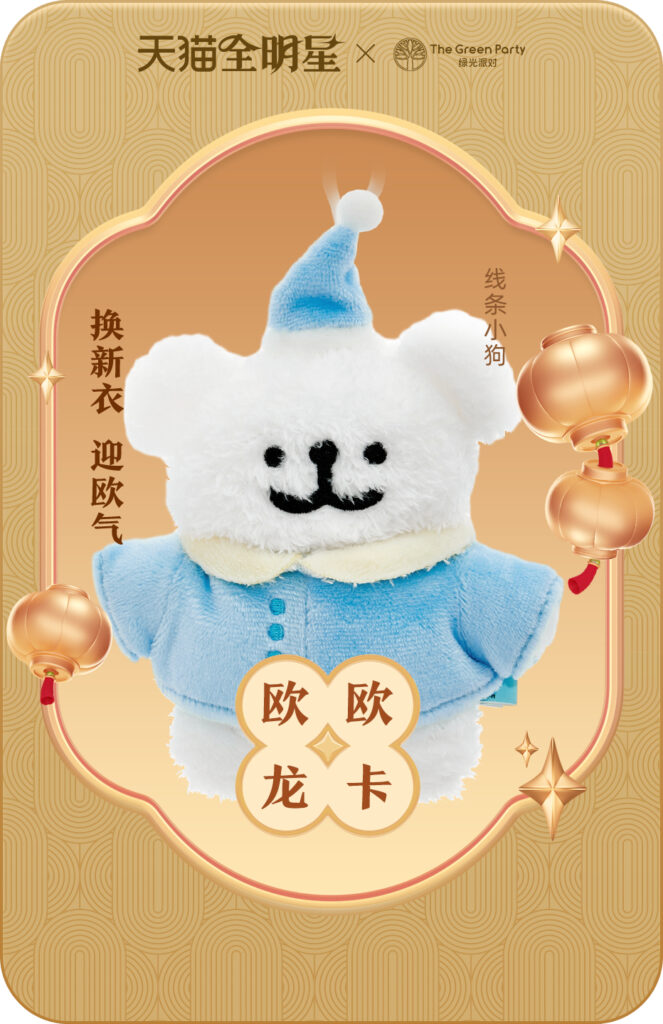
Tmall then uses Xiaohongshu (RED) and Weibo for its social characteristics. Derivative art like wallpaper, profile pictures, or even DIY physical cards are encouraged on Xiaohongshu.
Derivative art like wallpaper, profile pictures, or even DIY physical cards are encouraged on Xiaohongshu
Physical celebrity photocards, like other trading cards, are exchanged on Xianyu regularly. Xianyu is Alibaba’s second-hand dealing platform and recently opened its first offline location. Merch of the celebrity participating in the Tmall campaign can be won by publishing related posts.

Offline, a gallery of the Tmall New Year pictures has taken over the West Nanjing Road metro station in Shanghai. Billboards of the celebrities and their co-created New Year pictures are displayed along the walls of the busy interchange station.
Alipay and the five Fu’s
However, the Tmall co-creation is reminiscent of what Alipay, Alibaba’s payment arm, did with its “Collect the 5 Fu’s” event for last year’s Chinese New Year. “Fu” (福, lit. fortune or blessing) is a common blessing in China and is featured heavily during the holiday season.
Alipay has recently started its annual “Collect the 5 Fu’s” interactive event for users. Collecting the 5 Fu cards has been a tradition for Alipay since as early as 2016. Similar to that of a virtual easter egg hunt, Alipay users collect the cards by using Alipay’s app, mini programs within the app, or using it for offline purchases during the period leading up to the Chinese New Year. Innovative technologies such as AR scans were implemented during the hunt in the past.
For the Year of the Rabbit last year, Alipay brought out a basic version of the New Year AI co-creation picture function to the current Tmall campaign of searching for the Fu’s. Users could sketch out an outline of a rabbit and the AI would complete the image with a background. It was underwhelming in concept, interactivity and final result, in comparison to Tmall’s latest effort. This year, Alipay introduced further interactive AI functions to the event after upgrading it to the “Five Fu’s Festival”.
For the 2024 event, Alipay introduced 4 AI-incorporated interactive touchpoints for users to collect the Fu’s. The touchpoints include one that inserts user-uploaded photos into classic film scenes from the past 30 years. An AI-driven virtual red envelope allows users to send voice messages through AI-animated moving images based on uploaded photos. A “spacetime photo studio” allows people who are far apart to take group pictures with AI-generated images based on their own photos. The last mini-game generates random AI images with the Fu character hidden within them. Users will search for the Fu within the images.
On Weibo, China’s Twitter equivalent, the topic “Collect star cards to paint New Year pictures for the Year of the Dragon” (#龙年集星卡画年画#) has accumulated a whopping 2.16 billion views and 4.30 engagements, while the hashtag “Jackson Yee writes ‘Dragon’” (#易烊千玺写龙#) ranked number 6 on the Hot Search list with 210 million views.
The event also brought participating merchants exposure to different audiences. Dairy label Mengniu gained 3300% new members on the first day of offering the card draw and the event contributed 10% to the transactions of its store on Tmall. Luxury e-tailer NET-A-PORTER had a 377% year-on-year increase in traffic. FMCG giant Unilever saw 63% growth in shop visits by having the card draw function on its brand landing page.
With the latest AI tech, interactivity provided in the event has no doubt upgraded the often-one-sided star-fan relationship
The event successfully leveraged the star power of participating celebrities both in terms of social reach, traffic and transactions on the platform. With the latest AI tech, interactivity provided in the event has no doubt upgraded the often-one-sided star-fan relationship. For Alibaba, the Tmall event successfully linked various platforms internally between Xianyu and Tmall, and externally on social platforms. The creative usage is much more prominent than Alipay’s New Year picture from last year. Alipay’s activities this year, on the other hand, provide multiple uses for AIGC technology. These experiments can probably serve as inspirations for bigger things to come on other platforms, just as last year’s bunny drawing did for the eye-dotting of dragons on Tmall this year.




